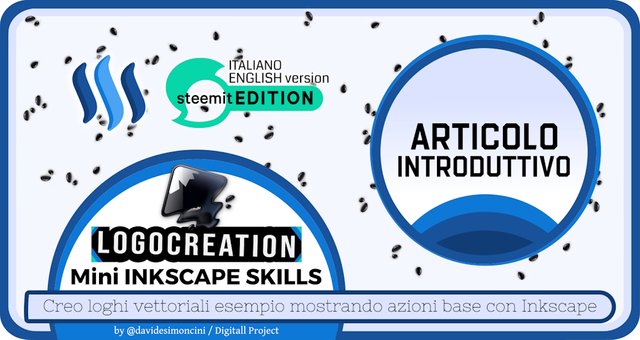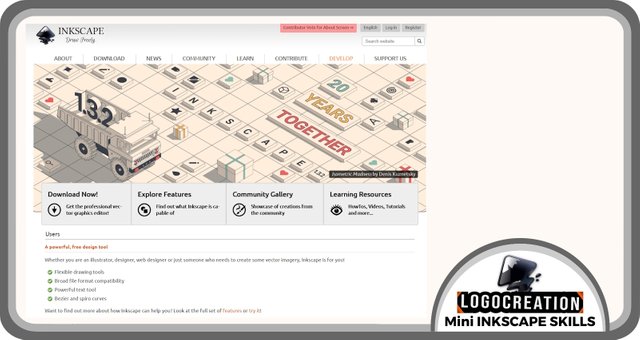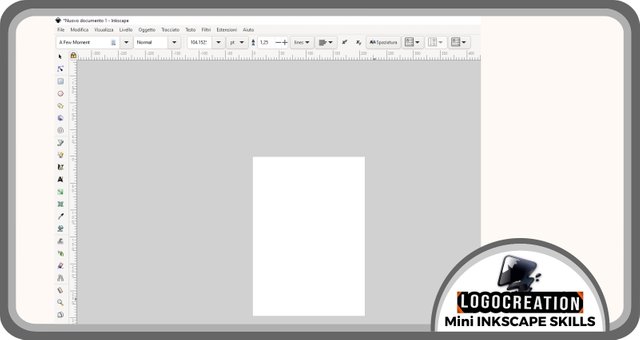You can find the ENGLISH translation after the italian text.
Tutti i diritti sono riservati.
È proibito ogni riutilizzo dei contenuti presenti in questo post – e dei loro derivati –, fatta eccezione la diffusione senza modifiche attraverso canali media e social media.

Ciao!
Oggi ho deciso di lanciare un piccolo spazio in cui periodicamente pubblicherò delle mini skills, utili a chi voglia imparare a utilizzare un programma di grafica vettoriale distribuito gratuitamente sul Web: Inkscape. Per iniziare dagli albori, è bene chiarire i punti salienti.
Disegnare usando il pc
Il graphic design è un campo che si è spostato sul digitale quasi in maniera obbligata per alcune delle sue fasi, e che forse con il tempo lo farà ancora di più se consideriamo la direzione che il mondo sta prendendo. Ma non tutti hanno bisogno di essere graphic designer di successo: a volte si ha soltanto necessità di conoscere le basi per creare in proprio un piccolo risultato; mi viene in mente un logo per un progetto personale da usare come elemento identificativo. Quindi, per portarla sul pratico, ti faccio due domande.
Vuoi imparare a progettare qualche logo o qualche semplice immagine digitale? E vuoi poter ingrandire il risultato a dismisura senza perdere la qualità dei dettagli?
Se la risposta è sì, ciò che fa per te è la progettazione in formato vettoriale. Questo tipo di progettazione prevede la creazione di elementi grafici secondo delle formule matematiche complesse e modificabili. Dico modificabili perché qui sta la differenza fondamentale tra un elemento vettoriale e un elemento non vettoriale (di cui un esempio può essere la classica foto che scatti con una macchina fotografica o un'immagine trovata sul web).
Nel caso di un'immagine comune, non vettoriale (che trovi in formato .jpg, .png, .tiff, eccetera) ciò che vedi rimane tale soltanto mantenendo le dimensioni a cui lo stai guardando. Se decidi di ingrandirlo o rimpicciolirlo, perderai dettaglio e introdurrai dei difetti.
Gli elementi vettoriali sono diversi: se ingrandisci o rimpiccolisci gli elementi, la qualità rimarrà immutata. Questa caratteristica si rende spesso necessaria nel mondo dell'imprenditoria o dei progetti che partono da zero e che guadagnano importanza con il tempo: questo perché – per esempio - elementi come loghi, marchi e template possono essere riadattati a materiale pubblicitario stile cartellonistica o maxischermi senza dover compromettere le loro qualità.
NOTA: non pensare di ricreare la qualità del dettaglio di una foto con un formato vettoriale, poiché sarebbe un risultato quasi impensabile. Le tecnologie concederanno forse di riuscirci ora o in futuro, ma è un obbiettivo molto al di là di chi si cimenta con i vettoriali per gli scopi sopra descritti.

E qui arriviamo a Inkscape: un'applicazione che permette di realizzare elementi in formato vettoriale e che viene distribuita gratuitamente sul Web. La puoi trovare sul sito ufficiale https://inkscape.org assieme a moltissime risorse per imparare basi e approfondimenti. Quello che mostrerò io all'interno del mio spazio sarà una serie di piccoli focus sulle funzionalità dell'applicazione. Queste funzionalità potrebbero però cambiare con il tempo, poiché talvolta vengono rilasciate nuove versioni con correzioni di bug precedentemente esistenti. I dettagli che questo spazio tratterà potrebbero quindi diventare obsoleti con il trascorrere dei mesi. Nel caso, ti invito ad affidarti ai canali ufficiali Inkscape per avere maggiori informazioni.

Detto questo, arrivo all'ultima parte di questa introduzione: all'interno di ogni post utilizzerò un logo immaginario che ho o che avrò creato. Questi loghi saranno soltanto esemplificativi, ma avranno spesso un carattere goliardico. Per crearli gioco infatti su doppi sensi, controsensi, luoghi comuni o concetti astratti che fanno a pugni l'uno con l'altro. Non sempre, ma abbastanza di frequente. Se ti accorgerai di questo, non scandalizzarti e non prenderla sul personale: è una caratteristica senza alcuna finalità discriminatoria o d'offesa. Stessa cosa se trovassi un nome che viene già utilizzato: quello che realizzo non fa riferimento specifico a nessun progetto o attività esistente.
Ultime puntualizzazioni
Questo post non ha come obbiettivo la promozione del programma Inkscape, sebbene indirettamente possa contribuirvi. Questo spazio nasce unicamente dalla mia esperienza personale nell'utilizzo di alcuni strumenti che quest'applicazione offre e che spero possano essere di aiuto a qualche “naufrago” in cerca di risposte.
E niente... se questa iniziativa può interessarti, consulta il mio blog di tanto in tanto. Non penso di riuscire a creare post a cadenza settimanale, ma spero di poter pubblicare un paio di articoli al mese. Deciderò poi se andare avanti a seconda del tempo e dei temi che avrò modo di condividere, oltre che del supporto che otterrò. Se ci fosse qualcosa che vuoi chiedere - magari una curiosità su come ottenere un certo risultato - ti esorto a domandarmelo nei commenti oppure scrivendo ai canali Digitall Project che trovi sul mio profilo Linktree (scritto nella descrizione della pagina personale del mio blog). Potrebbe magari essere un buono spunto per un successivo episodio e un valido aiuto per chi come te abbia avuto quella stessa curiosità.
Insomma, per oggi basta così: l'introduzione è finita. Ti saluto e spero di raggiungerti con il primo vero episodio del mio spazio.
Una buona settimana e a presto!
Below, you find the ENGLISH translation I previously published on Blurt.
All Rights Reserved.
All the uses of the contents herein - and their derivatives - are strictly prohibited without the explicit consent of the author, except for dissemination without modification through media and social media channels.

Hello!
Today I decided to launch a small space where I will periodically publish mini skills, useful for those who want to learn how to use a vector graphics program distributed free of charge on the Web: Inkscape. To start from the beginning, it's good to clarify the main points.
Digital drawing
Graphic design is a field that has moved towards digital spaces almost inevitably for some of its phases, and perhaps will do so even more if we consider the direction the world is taking. But not everyone needs to be a successful graphic designer: sometimes, you only need the basics to create a small result; I can think of a logo for a personal project to use as an identifying element. So, to make this practical, I'll ask you two questions.
Do you want to learn how to design simple logos or a few simple digital images? And do you want to enlarge the result dramatically without losing the quality of the details?
If your answer is "yes", design in vector format is right for you. This type of design involves the creation of graphic elements according to complex and editable mathematical formulas. I say editable because here lies the fundamental difference between a vector element and a non-vector element (of which an example could be the classic photo you take with a camera or an image found on the web).
In the case of a common, non-vector image (which you find in .jpg, .png, .tiff, etc. format) what you see keeps the same quality only by maintaining the dimensions at which you are viewing it. If you decide to make it bigger or smaller, you will lose detail and introduce defects.
Vector elements are different: if you make the elements bigger or smaller, the quality remains the same. This feature is often necessary in the world of entrepreneurship or projects that start from scratch and gain importance over time: this is because - for example - elements such as logos, brands and templates, can be adapted to billboard-style advertising material or giant screens without having to compromise their qualities.
NOTE: don't think of creating the detail of a photo with a vector format, as it would be an almost unthinkable result. Technologies perhaps allow us to achieve this now or in the future, but it is an objective far beyond those who try their hand at vectors for the described-above purposes.

And here we come to Inkscape: an application that allows you to create elements in vector format and which is distributed free-of-charge on the Web. You can find it on the official website https://inkscape.org with many resources to learn basics and in-depth information. What I will show you in my space will be a series of small focuses on the functionalities of the application. However, these features may change over time, as new versions are sometimes released with fixes to previously existing bugs. The details I will talk to you about could become obsolete as the months pass. In this eventuality, I invite you to rely on the official Inkscape channels for more information.

After saying this, I come to the last part of this introduction: within each post, I will use an imaginary logo I created. These logos are only illustrative but often have a playful character. To create them, I play on double meanings, contradictions, clichés or abstract concepts that are at odds with each other. Not always, but quite frequently. If you notice this, don't be scandalized and don't be spiteful: it is a characteristic without any discriminatory or offensive purpose. It is the same eventuality if you find a name already used: the one I create doesn't specifically refer to any existing project or activity.
Last clarifications
This post isn't intended to promote the Inkscape project, although it may indirectly contribute to it. This space was born solely from my personal experience in the use of some tools that this application offers. I hope I can help some "castaways" who are looking for answers.
And nothing... if this initiative might interest you, occasionally consult my blog. I don't think I can create posts each week, but I hope to publish a couple of articles every month. I will then decide whether to continue depending on the time and the themes I will have the opportunity to share, as well as the support I will get. If there is something you want to ask - perhaps a curiosity about how to obtain a certain result - I urge you to ask me in the comment section or by writing to the Digitall Project channels that you find on my Linktree profile (in the description of the personal page of my blog). It could be a good starting point for a subsequent episode and a valid help for those who have the same curiosity.
That's it: the introduction is over. I greet you and hope to reach you with the first real episode of my initiative.
Great tutorial
💯⚜2️⃣0️⃣2️⃣4️⃣ This is a manual curation from the @tipu Curation Project.
Also your post was promoted on 🧵"X"🧵 by the account josluds
@tipu curate
Downvoting a post can decrease pending rewards and make it less visible. Common reasons:
Submit
Upvoted 👌 (Mana: 5/6) Get profit votes with @tipU :)
Downvoting a post can decrease pending rewards and make it less visible. Common reasons:
Submit
Thank you Joslud, and the same for your curation :)
Downvoting a post can decrease pending rewards and make it less visible. Common reasons:
Submit
La progettazione grafica, anche se sono stato molto impegnato, è una delle abilità che ho ammirato di più per imparare.
Downvoting a post can decrease pending rewards and make it less visible. Common reasons:
Submit
Può essere utile in diverse occasioni, dipende dai settori in cui una persona si muove. Grazie per esserti fermato sul mio blog :)
Downvoting a post can decrease pending rewards and make it less visible. Common reasons:
Submit
Thank you, friend!


I'm @steem.history, who is steem witness.
Thank you for witnessvoting for me.
please click it!
(Go to https://steemit.com/~witnesses and type fbslo at the bottom of the page)
The weight is reduced because of the lack of Voting Power. If you vote for me as a witness, you can get my little vote.
Downvoting a post can decrease pending rewards and make it less visible. Common reasons:
Submit